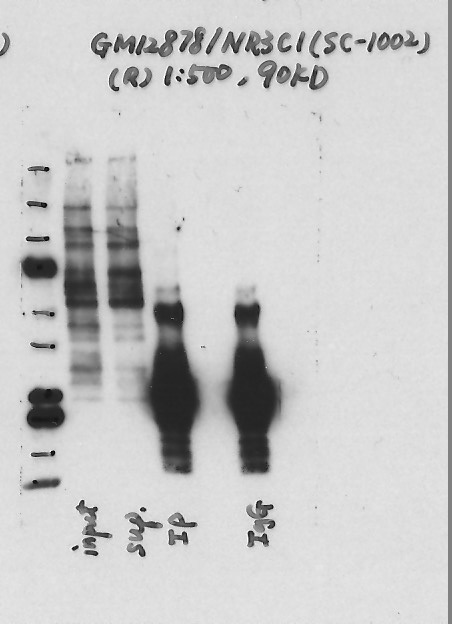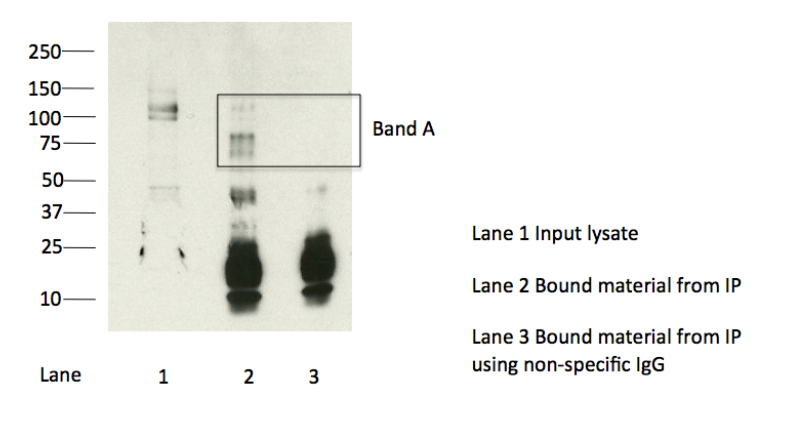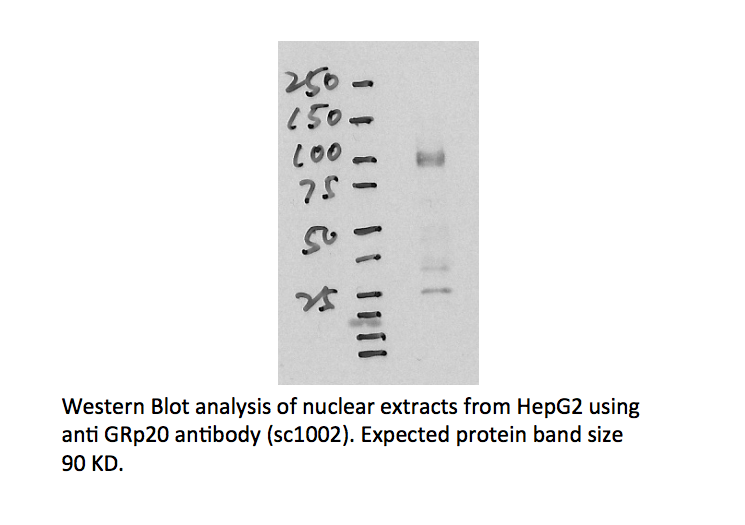ENCAB000AHC
Antibody against Homo sapiens NR3C1
Homo sapiens
HepG2
characterized to standards
Homo sapiens
any cell type or tissue
partially characterized
- Status
- released
- Source (vendor)
- Santa Cruz Biotech
- Product ID
- sc-1002
- Lot ID
- I0310
- Characterized targets
- NR3C1 (Homo sapiens)
- Host
- rabbit
- Clonality
- polyclonal
- Purification
- affinity
- Isotype
- IgG
- Antigen description
- Epitope mapping at the C-terminus of GR alpha of human origin
- External resources
Characterizations
NR3C1 (Homo sapiens)
not submitted for review by lab
- Caption
- Immunoprecipitation was performed on nuclear extracts from the cell line: A549, using the antibody sc-1002. The blot shows western blot analysis of input, flowthrough, immunoprecipitate and mock immunoprecipitate using IgG.Molecular Weight: 90.0
- Submitted by
- Nathaniel Watson
- Lab
- Michael Snyder, Stanford
- Grant
- U54HG006996
- Download
- Expt1130_7-NR3C1-sc-1002-A549.JPG
NR3C1 (Homo sapiens)
not submitted for review by lab
- Caption
- Immunoprecipitation was performed on nuclear extracts from the cell line: GM12878, using the antibody sc-1002. The blot shows western blot analysis of input, flowthrough, immunoprecipitate and mock immunoprecipitate using IgG.Molecular Weight: 90.0
- Submitted by
- Nathaniel Watson
- Lab
- Michael Snyder, Stanford
- Grant
- U54HG006996
- Download
- GM12878-NR3C1.jpg
NR3C1 (Homo sapiens)
Method: immunoprecipitation followed by mass spectrometry
not reviewed
- Caption
- Immunoprecipitation of GRp20 from HepG2 cells using sc-1002 antibody. Lane 1: input nuclear lysate, Lane 2: material immunoprecipitated with sc-1002, Lane 3: material immunoprecipitated using control IgG. Bands A was excised from the gel and subjected to analysis by mass spectrometry." IP followed by masspectrometry: Briefly, protein was immunoprecipitated from HepG2 whole cell lysates using sc-1002, and the IP fraction was loaded on a 10% polyacrylamide gel (NuPAGE Bis-Tris Gel) and separated with an Invitrogen NuPAGE electrophoresis system. The gel was silver-stained, gel fragments corresponding to the bands indicated were excised and destained using the SilverSNAP Stain for Mass Spectrometry (Pierce). Then proteins were trypsinized using the in-gel digestion method. Digested proteins were analyzed on an LTQ- Orbitrap (Thermo Scientific) by the nanoLC-ESI-MS/MS technique. Peptides were identified by the SEQUEST algorithm and filtered with a high confidence threshold (Protein false discovery rate < 1%, 2 peptides per protein minimum)." We report 38 proteins identified in band A, although 11 of these are also present in a control immunoprecipitation and are thus likely to present due to non-specific association with the IP matrix. Of the specifically immunoprecipitated proteins, GRp20 is the most abundant (99 peptides). Based on these observations, this band is likely due to the presence of immunoprecipitated GRp20 and Sc-1002 meets the ENCODE standard for validation by this criterion.
- Submitted by
- Michael Snyder
- Lab
- Michael Snyder, Stanford
- Grant
- U54HG004558
NR3C1 (Homo sapiens)
Method: immunoblot
not reviewed
- Caption
- Western blot of HepG2 nuclear extracts using the anti GRp20 (sc-1002) detects a single high molecular weight protein of about 90kD. Thsi band was analyzed further by IP-Mass Spec.
- Submitted by
- Michael Snyder
- Lab
- Michael Snyder, Stanford
- Grant
- U54HG004558
NR3C1 (Homo sapiens)
HepG2
compliant
- Caption
- Immunoprecipitation of GRp20 from HepG2 cells using sc-1002 antibody. Lane 1: Input Lysate. Lane 2: Materia immunoprecipitated with sc-1002. Lane 3: Material immunoprecipitated using control IgG. bands A was excised from the gel and subjected to analysis by mass spectrometry.
- Submitted by
- Kathrina Onate
- Lab
- Michael Snyder, Stanford
- Grant
- U54HG004558
- Download
- IP Snyder AHC.png
NR3C1 (Homo sapiens)
Method: immunoprecipitation followed by mass spectrometry
compliant
- Caption
- IP followed by masspectrometry: Briefly, protein was immunoprecipitated from HepG2 whole cell lysates using sc-1002, and the IP fraction was loaded on a 10% polyacrylamide gel (NuPAGE Bis-Tris Gel) and separated with an Invitrogen NuPAGE electrophoresis system. The gel was silver-stained, gel fragments corresponding to the bands indicated were excised and destained using the SilverSNAP Stain for Mass Spectrometry (Pierce). Then proteins were trypsinized using the in-gel digestion method. Digested proteins were analyzed on an LTQ- Orbitrap (Thermo Scientific) by the nanoLC-ESI-MS/MS technique. Peptides were identified by the SEQUEST algorithm and filtered with a high confidence threshold (Protein false discovery rate < 1%, 2 peptides per protein minimum)." We report 38 proteins identified in band A, although 11 of these are also present in a control immunoprecipitation and are thus likely to present due to non-specific association with the IP matrix. Of the specifically immunoprecipitated proteins, GRp20 is the most abundant (99 peptides). Based on these observations, this band is likely due to the presence of immunoprecipitated GRp20 and Sc-1002 meets the ENCODE standard for validation by this criterion.
- Submitted by
- Kathrina Onate
- Lab
- Michael Snyder, Stanford
- Grant
- U54HG004558
- Download
- MS Snyder AHC.pdf
NR3C1 (Homo sapiens)
HepG2
compliant
- Caption
- Western Blot analysis of nuclear extracts from HepG2 using anti GRp20 antibody (sc1002). Expected protein band size 90 kD.
- Submitted by
- Kathrina Onate
- Lab
- Michael Snyder, Stanford
- Grant
- U54HG004558
- Download
- WB Snyder AHC.png


